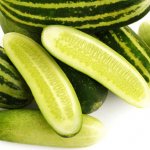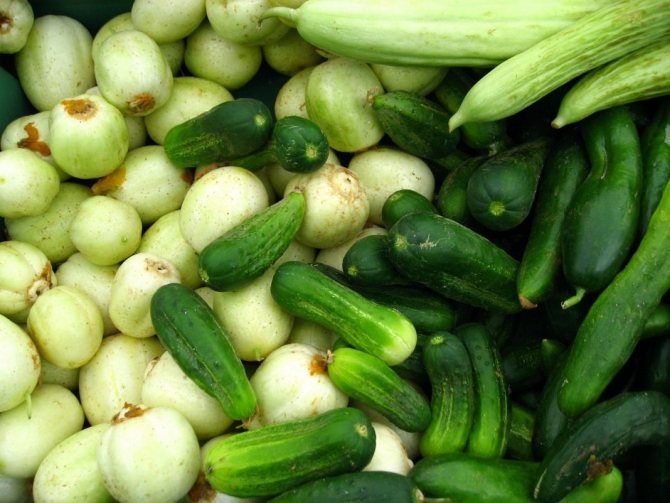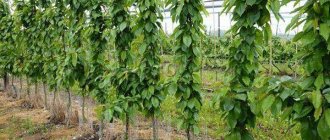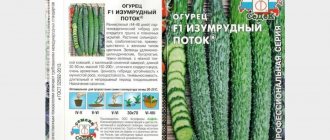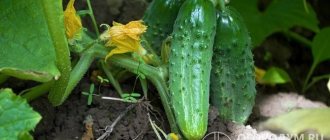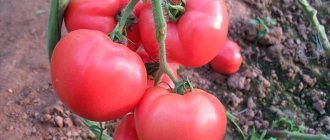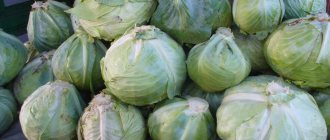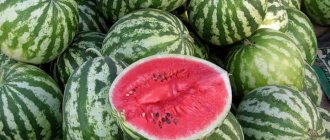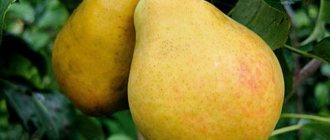Different countries have their own vegetable culture, comparable to our cucumber. True, the characteristics of the overseas vegetable are in many ways different from the biological indicators of domestic zelents. Distant "relatives" of the usual cucumber amaze with a variety of shape, color and even taste. Enthusiastic gardeners are experimenting with exotic varieties of domestic greens, growing them in their summer cottages. It turns out, by the way, not bad.
- 2 Armenian cucumbers
- 3 White cucumbers
- 4 Lemon cucumber
- 5 Italian cucumbers
- 6 Melotria rough
- 7 Momordika
- 8 Trihozant
- 9 Doubtful Tladiant
Chinese cucumbers
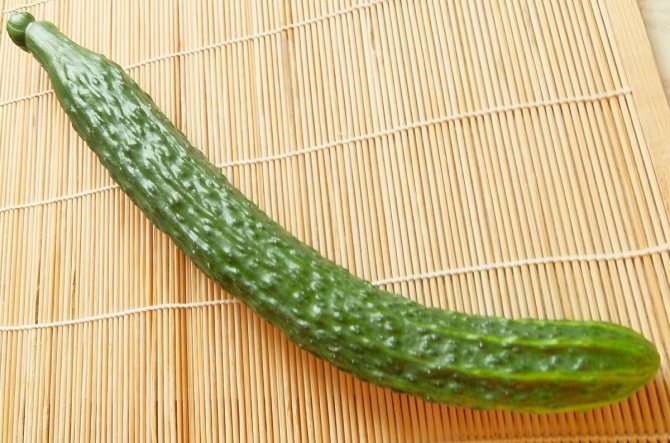
The vegetable got this name in China, from where it comes from. The following subspecies are popular:
- Chinese long-fruited.
- Chinese miracle.
- Chinese snakes.
- Chinese white.
- Chinese farm.
- Chinese disease resistant.
The giant fruits immediately attract attention with their unusual appearance and pleasant taste, slightly reminiscent of a watermelon. After sowing, approximately 20-25% of the seeds germinate, therefore, for the best yield, it is necessary to sow more seeds. Vegetable stems sometimes grow up to 3-3.5 meters, and the fruit itself is 50-80 centimeters in length.
In Nursing, the Chinese are completely unpretentious, grow in different types of soil and practically do not get sick. They can be cultivated in any climatic zone of the country. Agronomists advise to follow the rule when caring for a cucumber crop - it is better to place the lashes vertically along their entire length. So more light will get on the ovary, and the fruits will form in the correct elongated-oval shape. If during the growing season there was insufficient watering, then the taste of zelents may be slightly bitter. All Chinese varieties are early, so fresh fruits can be picked at the beginning of May.
Important! The downside of Chinese cucumbers is poor keeping quality. Zelentsy retain their commercial characteristics for 2-3 days, then begin to dry, become tasteless. Therefore, they are best consumed immediately after removal from the bush.
Unusual common features of exotic cucumbers
White cucumber
White cucumbers differ from ordinary green ones only in color. Having lost the green color of the fruit, white-colored cucumbers have acquired a lot of useful properties. They can withstand hot weather up to + 45 ° С, are resistant to diseases and pests. Fruits up to 20 cm long are formed. Zelens 8-12 cm are used for food. The pulp is tender, sweetish in taste, a recognized delicacy among cucumbers.
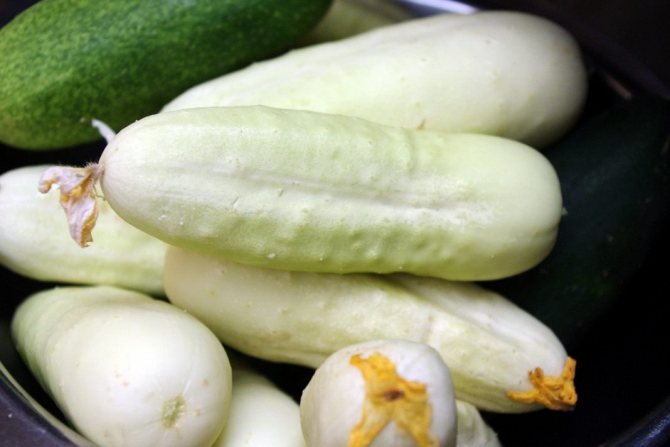

White cucumber. <>
Popular varieties for home cultivation: Snow White, Italian White, Bride, Snow Leopard, White Angel and others.
They belong to the long-leaved group. Therefore, it is better to grow them on special nets or trellises. They are characterized by frost resistance and shade tolerance. Seeds are sown in open ground in late April - early May. Crops are covered with foil, agrofibre or other covering material. Fruiting before frost. Agrotechnics of care are common for cucumbers.
Chinese serpentine
The most common and familiar to summer residents are Chinese cucumbers, the long fruits of which hang down like snakes. Hence the name of the varieties Chinese snakes, Chinese long-fruited, Chinese miracle, Chinese white and others. Our varieties have appeared on the Russian market: Emerald Stream, Udav and others.


Chinese serpentine cucumber. <>
They grow with equal success in open ground and in greenhouse conditions.Scourges up to 3.5 m, covered with large leaves with a slightly rough surface, are decorative, and fruits from 40 to 90 cm long amaze with excellent taste: they never taste bitter, the pulp is tender, sweetish taste with a subtle aroma of ripe watermelon. To obtain a bountiful harvest, root and foliar top dressing with nitrogen, boron, potassium, and calcium is required. The lack of these elements affects the taste and external shape of the fruit. The fruits become hooked and tasteless. When removed, they quickly lose moisture and shrink. Therefore, they are used immediately after harvesting. Practically not subject to storage. Harvest as needed to prolong use. Chinese cucumbers are propagated by seeds, but the germination of the latter does not exceed 20-25%, therefore, they always carry out a thickened sowing, followed by a breakthrough.
Kiwano
Kiwano is an African cousin of the common cucumber family. The exotic appearance of the fruit has determined a number of popular names: African cucumber, English tomato, horned melon.
Like Chinese cucumbers, Kiwano form 3-meter thin, strong stems climbing on supports. Fruits, up to 15 cm long, yellow or orange, are covered with soft "thorns". The sweet and sour taste of the jelly-like, bright green pulp is reminiscent of a banana or regular cucumber.
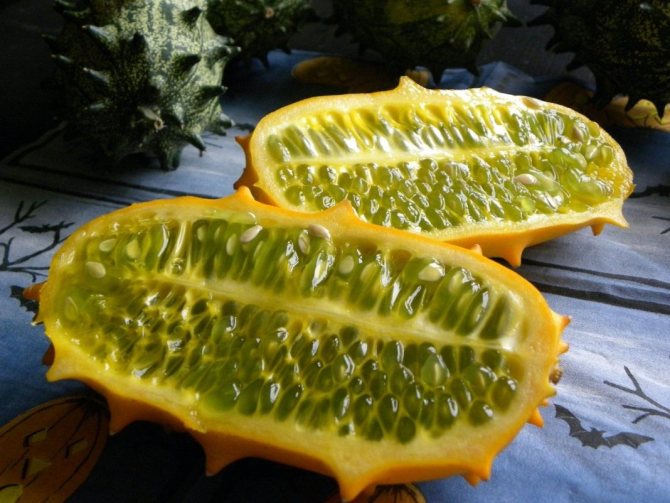

Kiwano, or horned melon, or African cucumber (Cucumis metulifer).
Kiwano, in addition to its exotic appearance, has a number of useful properties. Its fruits are especially beneficial when fresh. They are high in magnesium, phosphorus, potassium and other elements and vitamins. They have medicinal properties and are used for problems with the gastrointestinal tract, cardiovascular system, and immunity. Kiwano is widely used for cosmetic masks. Fruits are part of the preparation of ice cream, cakes, salads, dessert dishes, cocktails. Kiwano green fruits are used in salads like regular cucumbers.
Chayote - Mexican Cucumber
Chayote, in terms of its taste and appearance of the fruit, is a more distant relative of Kiwano and common cucumber. Its fruit is shaped like an unusually large unripe light green pear. The inside of the fruit is a juicy white flesh. The taste of the pulp is sweetish.
Chayote needs special growing conditions:
- abundant watering with water heated to 25 ° С,
- the soil is limed before planting, since chayote does not tolerate acidification,
- the growing season is up to 180 days. Refers to the group of short-day plants. Chayote blooms only when the day length is no more than 12 hours,
- does not tolerate cold soil, the temperature of which must be at least + 15 ° С,
- plants need a sufficient area (2x2 m).
At the same time, it is a very interesting viviparous plant. For reproduction, whole fruits are used, which are placed in the soil at an inclination of 45 degrees with the wide side down. Fruits are covered with soil by 2/3. First, the root system is formed, and then young shoots with leaves appear from the upper aerial part. There are many shoots, so plucking is carried out, leaving 2-3 of the strongest shoots. With its antennae, the plant clings to the support and stretches upward. In order for the plant to bloom, the light period is artificially reduced by covering the plants with an opaque material. Agrotechnics for plant care are common for cucumbers.
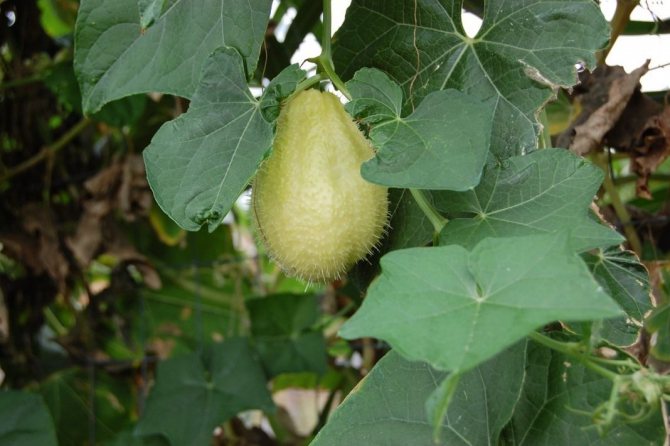

Edible chayote, or Mexican cucumber (Sechium edule).
Lack of culture - large, heavy fruits on a thin stalk break off in the wind, damage and rot. When ripe, the harvest is removed carefully, since damaged fruits are not stored. With proper fruit picking, the harvest is stored for up to six months. Cucumbers are harvested in September and stored at +3 .. + 5 ° С. Previously, the stalks are removed from the fruit and dried for several days at room temperature.
Chayote is used fresh as ordinary cucumbers. Hot dishes are prepared: stew, fried, stuffed like zucchini.
The rest of the chayote plant can also be used for food. Leaves and shoots are stewed, and young tubers of Mexican cucumber, rich in starch, can replace potatoes.
Melotria rough
Melotria rough (the next exotic from Africa) is also called a mini-cucumber for the miniature size of the fruits (1.5-2.5 cm), which resemble toy watermelons. In terms of taste and use, they may well replace ordinary cucumbers. Used for salads and processing (salting, canning).


Melotria rough (Melothria scabra). <9dr7
Melotria in central Russia is grown as an annual crop through seedlings. Seeds are sown in prepared mini-greenhouses at the end of March-April in a 0.5 cm layer of wet soil. At a temperature of +25 .. + 27 ° C, seedlings appear in 5-7 days. Transplanting seedlings does not affect the developmental activity and after 2-4 weeks the vines reach 3-4 m in length and bloom. In a sunny, warm area (without drafts), with systematic feeding after 1.5-2.0 weeks and weekly watering, seedlings planted in a permanent place form the first fruits on days 14-18.
Lovers of the exotic grow melotria as an ornamental culture. Bright green leaves do not lose their green color throughout the warm season, and rapid growth allows you to plant trees on a large area of arbors and rotundas in a short time.
Armenian cucumbers
The Armenian cucumber is also called silver melon - the Central Asian brother of the pumpkin family. The most popular varieties among the population include White Bogatyr, Silver Melon.
Like the above-described species, Armenian cucumbers are easily cultivated in open and protected ground. They do not get sick, are resistant to temperature extremes. They are distinguished by long-term fruiting. They form whips up to 4 meters and need supports.
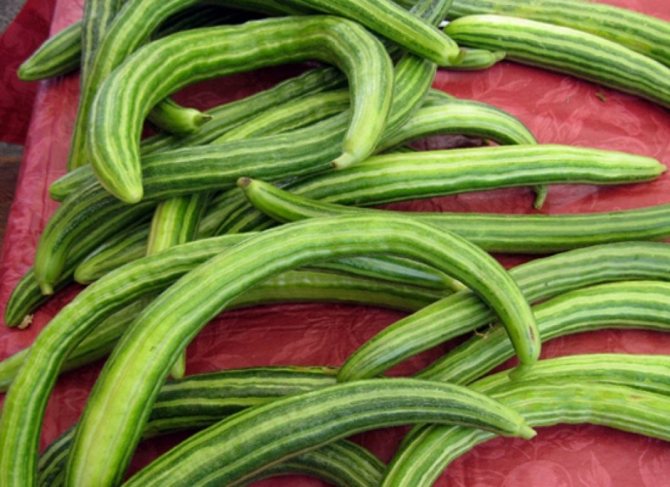

Armenian cucumbers.
The Armenian cucumber has a very interesting external shape of the fruit. Long (like Chinese) up to 50 cm, it is covered with soft silvery pubescence. The weight of one mature fruit reaches a kilogram. The taste is somewhat peculiar, designed for the amateur. Some fans of exotic vegetables believe that they taste like pumpkin, others compare them to melon.
Momordica
Momordica belongs to Indian cucumbers. Cucumber has several synonyms - bitter melon, bitter apple, allspice pear, bitter gourd.
It can be freely grown in open ground, on a windowsill, on a balcony, or a loggia. For the decorativeness of vegetative organs, flowers and fruits, momordica is especially appreciated by landscape decorators. Bright yellow flowers with a jasmine scent are very attractive. Fruits change their shape and color during development. Long greens (6-8 cm) resemble cucumbers, and the bumpy surface is a crocodile skin. The resemblance to a crocodile increases with ripening of the fruit. They gradually change the green color of the fruit to orange. The lower part of the fruit cracks and during this period of time it resembles the open mouth of a crocodile, filled with bright red or bright crimson seeds in a jelly-like pulp. For this amazing similarity, the Indian momordiku cucumber is called the "crocodile cucumber". Young greens taste like zucchini, unripe pumpkin and cucumber at the same time. Ripe fruits are sugary sweet with bitterness. For its peculiar taste, the fruits are used only by lovers of exotic vegetables.
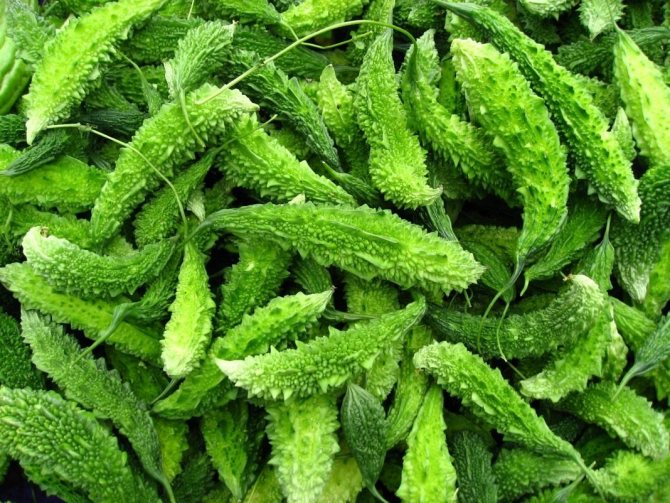

Momordica charantia, or bitter cucumber (Momordica charantia).
When grown from seeds, the latter are necessarily scarified with sandpaper, disinfected, wrapped in a cloth, which is constantly moistened, placing for 2-4 days in a warm (+ 25 ° C) place. A nutrient mixture is prepared in advance in pots, where cracked seeds are sown in the second half of March. The waiting period for seedlings is 2 weeks. The soil must be constantly moist.In the second half of May, momordica is planted in open ground. Damage to the delicate root system will lead to the death of the plant. Rooted plants are fed with boric acid solution (foliar) and nitrophosphate. In the southern regions, Momordica is successfully grown by sowing seeds in open ground. Agrotechnics are common for cucumbers.
Momordica is used in the treatment of certain types of tumors, eye diseases, cardiovascular system, to increase immunity.
Italian cucumbers
Italian cucumbers are a miracle of Italian selection. They resemble Armenian with long pubescent fruits and long fruiting. Agrotechnics are common. The most common and recognizable varieties of Italian cucumbers are Watermelon (Tortarello) and Barrese.
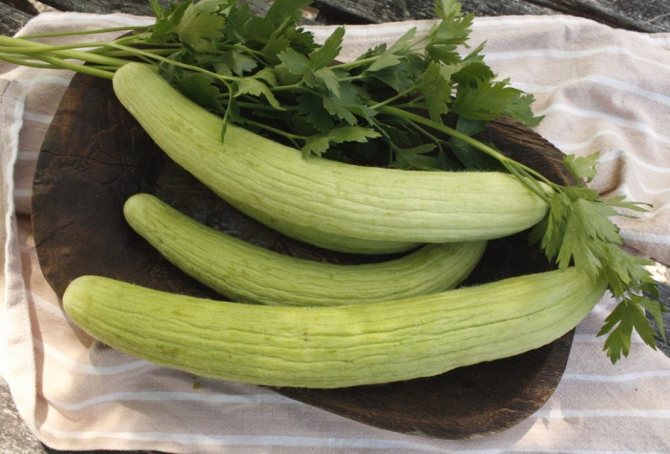

Italian cucumbers Watermelon (Tortarello). <>
For the Arbuzze variety, a light green fruit surface with pronounced ribbing is typical. Fruits over 50 cm. They have a mixture of watermelon and cucumber flavors. The pulp of the fruit is sweetish.
In Barrese fruits, the color is dark green, changing to yellow-orange at maturity. The taste and aroma of the fruit is reminiscent of a melon.
English Lemon Cucumber
In appearance, the lemon-cucumber really looks more like a lemon than a cucumber. A distinctive feature of the fruit is the high content of crystal-clear moisture in the pulp. In the zelentz phase, the fruits are light green in color. By ripening, they acquire a light yellow color, pleasant aroma and taste. The surface of the fruit is covered with a silky fluff. The culture bears fruit until the frost. Used fresh and canned. When processed, the fruits retain their color and shape without changing. The lemon cucumber has one feature: the lashes reach a length of up to 6 m and form fruits only when placed on supports.


Cucumber-Lemon. <>
In the south, seeds are sown in early June directly into the soil. The plant is truly southern, therefore, in central Russia it is grown through seedlings. Seeds are sown in mini-greenhouses in March-April in light water- and air-permeable soil, sufficiently supplied with nutrients. Before germination, the soil is kept moist, and the temperature is not lower than +22 .. + 25 ° С. Seedlings are planted in the second half of May - early June in the garden. In the open field, agricultural technology is common. Lemon cucumber loves moisture and responds well to watering, but it is able to extract moisture from the air and thus wait out the dry season.
Trihozant
Trichozant, or snake-like cucumber from Southeast Asia. Its name derives from the external shape of the fruit, which resembles writhing dark green snakes, which eventually change color to a bright red-orange color. In length, the fruits reach 1.2 meters. In the regions of Russia, Trichozant is not widespread, and in the countries of Southeast Asia it is cultivated as a vegetable crop. In Russia, it is grown mainly by lovers of exotic plants because of its decorative effect. Like other species, Trichozant is unpretentious in care. The flowers of the Trichozant are very unusual: small, no more than 4 cm, they resemble snowflakes. Given the thermophilic nature of the culture, Trichozant is propagated through seedlings, sowing seeds in mini-greenhouses in the first decade of May, and for a permanent meal in early June. Basically, Trichozant grows in open ground only in the southern regions. In the middle lane, this is a greenhouse plant.
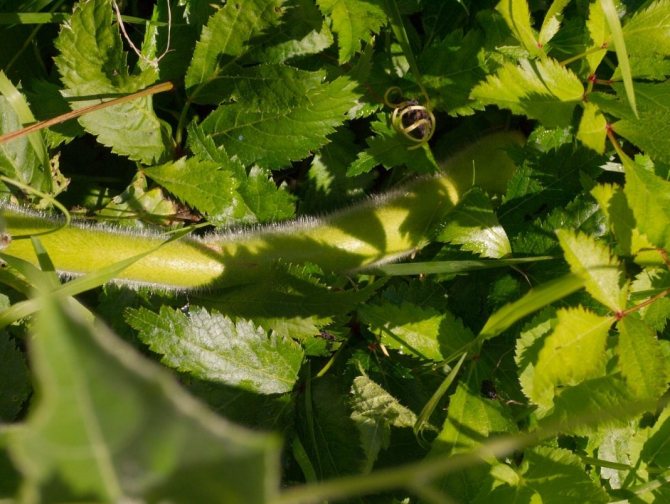

Kirilov's trichozant (Trichosanthes kirilowii), or Japanese Trichosanthes japonica, or Snake cucumber.
Doubtful tladianta
Another representative of the pumpkin from Southeast Asia. The climbing liana of 5 meters in height has an extraordinary decorative effect. Light green, heart-shaped leaves and bright yellow tulip-shaped flowers create phytowalls of extraordinary beauty. Flowering continues throughout the warm period. Cucumbers form at the base of the flowers. Green fruits can be used for canning. As they ripen, the cucumbers turn red.The red fruits are very sweet and are used to make jam. Fruiting is provided by hand pollination, but taking into account the late development of female flowers, it is difficult to get mature fruits.
The culture is propagated by seeds and tubers similar to potatoes. Tuberous propagation is the most acceptable and time-saving one. Tubers are planted 8-10 cm in the second decade of April and in the second decade of May the first shoots appear. The aboveground part dies off in autumn, and the tubers overwinter in the soil. In one place without a transplant, Tladiant can grow up to 10 years.
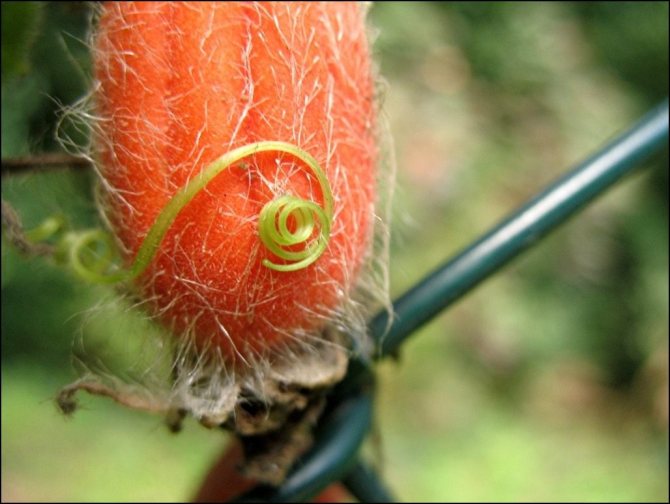

Doubtful Tladiantha (Thladiantha dubia).
Cucumber seeds are propagated through seedlings. Seeds are usually stratified in a refrigerator or unheated room. In early March, seeds are sown superficially on a prepared moist substrate. Seedlings thrive in low light and medium temperatures of at least 0 ° C. Seedlings are successfully obtained by growing on glazed loggias or balconies. Tladianty seedlings are planted in a permanent place, like the Trichozant, in late May - early June. Agrotechnics are common. The culture needs constant moderate watering, does not tolerate waterlogging (tubers die).
Armenian cucumbers


The homeland of the vegetable is Central Asia. The silvery-white fruit is covered with a small fluff, 45-50 centimeters long and weighing up to 1 kilogram. This fruit is sweeter than Chinese cucumber, with aromatic notes of melon and pumpkin. Popular subspecies of Armenian cucumber:
- Silver melon.
- The hero is white.
- Melon Flehois.
The pulp of the vegetable has no air space inside, it stays juicy longer. Cucumbers bear fruit before the first frost and can be well preserved.
Advice! This vegetable must be added to the diet of those who suffer from diabetes mellitus, atherosclerosis, hypertension.
White cucumbers
Among the varieties of cucumbers, white ones are delicacies, and by tasting their sweetish pulp, one can be convinced of this. Their color is white, slightly greenish, the skin is thin, and the flesh is juicy and very tasty.
Several subspecies cultivated in Russia are currently popular:
- White angel.
- Snow White.
- Bride.
- Snow Leopard.
- White Italian.
Plants are heat-resistant, adapting to growth even at 45 degrees. They are also resistant to cold, unpretentious. The crop is planted in April by sowing in open soil. Cucumbers bear fruit until the end of autumn.
General characteristics of the plant
Momordica is a pumpkin plant. The fruits are oblong.
Initially, the plant was grown in Asia, Africa, Australia. There is information about the breeding of Momordiki in the Crimea. In Russia, the plant appeared not so long ago. It is actively grown in greenhouses, balconies, and window sills.
Momordica is a climbing plant in the form of vines... It is distinguished by its decorative beauty. Vines reach 2 meters, the leaves are large. During flowering, a large bright yellow flower with a pleasant aroma appears.
The fruits reach 25 centimeters. They have an oval, slightly oblong shape. Specific growths are located on the upper part.
When ripe, the peel of the fruit changes color to yellow or orange.... The pulp is juicy and has a ruby color. After ripening, the fruit cracks along the bottom and opens.
What is Momordica:
Cucumber-lemon


This vegetable is native to Australia. The breeders of this country brought out an exotic vegetable that looks like a lemon on the outside, but tastes like an ordinary cucumber. During the growth period, the skin color changes from light green to bright yellow. Lemon cucumber loves a moist and warm environment for growth. It is cultivated by seedling, and watered abundantly during growth. The vegetable retains its unusual yellow color even when canned.
Advice! A wonder of British selection - a natural source of vitamin C. It is low in calories and suitable for obese people.
Beneficial features
Momordica has gained its popularity due to its medicinal properties. The fruits and shoots of this useful culture are rich in carotene, insulin-like peptides, calcium, fatty oils, alkaloids, phenols, amino acids, sapolins.
Indian cucumber allows you to get rid of many diseases, including such dangerous ones as cancer. The plant is able to normalize blood pressure, reduce the glycemic index and eliminate tumor neoplasms at the initial stage. It is recommended for diabetics to maintain normal health, which is provided by the carotene, peptides and alkaloids included in the culture.
Momordica seeds are used to treat the gastrointestinal tract. Since they contain a large amount of fat, they effectively heal ulcerative lesions of the stomach and intestines.
The plant has a strong diuretic effect, therefore it effectively removes fluid from the body, and also cleanses the biliary tract, preventing bile stagnation.
Momordica leaf plates have a pulling property. For this reason, they are applied to the wound surface and to the bites of poisonous reptiles and insects. Lotions based on them eliminate pain, remove toxic substances and eliminate the inflammatory process.
The pulp of the fruit contains a large amount of vitamins that have a positive effect on eyesight, nails, skin, teeth and hair.


Since the fruit contains vitamin C, it can be used for ailments of viral etiology. Apart from this, it has strong antioxidant properties.
The use of Momordica improves vascular permeability, normalizes blood clotting and eliminates inflammation. In dietetics, it is used due to the fact that it effectively normalizes metabolic processes in the body, stimulates weight loss and is a natural, safe energy drink that helps to reduce food consumption and convert it into energy, not fat.
Among the useful properties of momordica are:
- Eliminates vitamin deficiency.
- Improves vision and condition of nails, hair, skin, teeth.
- Regulates redox processes in the body (inhibits the development of cancer cells).
- Has anti-inflammatory effect.
- Supports normal blood clotting, blood vessel permeability, the functioning of the nervous system, bone apparatus.
- Stimulates insulin production.
- Removes toxins.
- Destroys bacteria and viruses.
Italian cucumbers
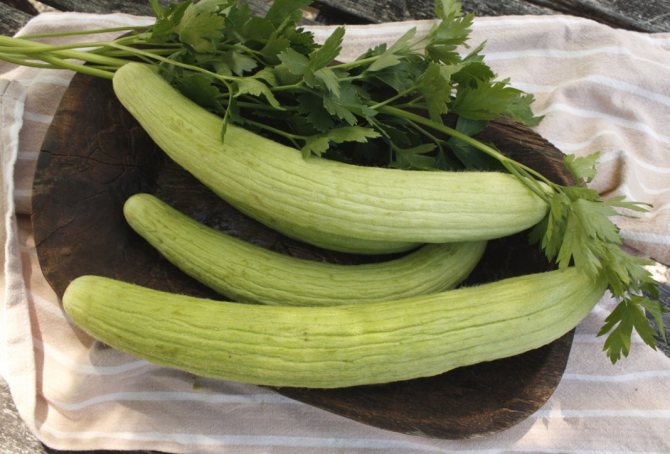

It is easy to guess about the country of origin of this vegetable - Italy. Italian cucumbers are oblong in shape, grow up to 50 centimeters in length. Their skin is fluffy, slightly ribbed. There are two varieties of Italian cucumbers:
- Watermelon (Tortarello) Vegetable sweetish in taste, reminiscent of watermelon, but with the brightest salad color. Unripe Tortarello is used in a variety of dishes, like ordinary cucumbers, and ripe Tortarello is used in unconventional cuisine.
- Barrese. Barrese is deep green in color, during maturation a bright orange shade similar to melon is obtained. Late ripening product does not overripe. Barezze's whips are short, so you don't have to tie them to the support.
The flowering of Italian cucumbers is predominantly night. Therefore, the gardener may have difficulties with pollination - due to the lack of bees at night, they will have to resort to artificial pollination.
Causes of yellowing of the ovary of cucumbers independent of humans
Sometimes the ovaries turn yellow due to the biological characteristics of the cucumber. Recently, gardeners are tired of traditional low-yielding cucumber varieties and are testing new hybrids. On the latter, much more fruits are formed: sometimes they grow from the axils of the leaves in bunches. However, some of these cucumbers will certainly turn yellow, since one plant cannot grow an infinite number of them, but only 20-30 pieces. "Extra" fruits over time simply dry up, thus the plant self-regulates.
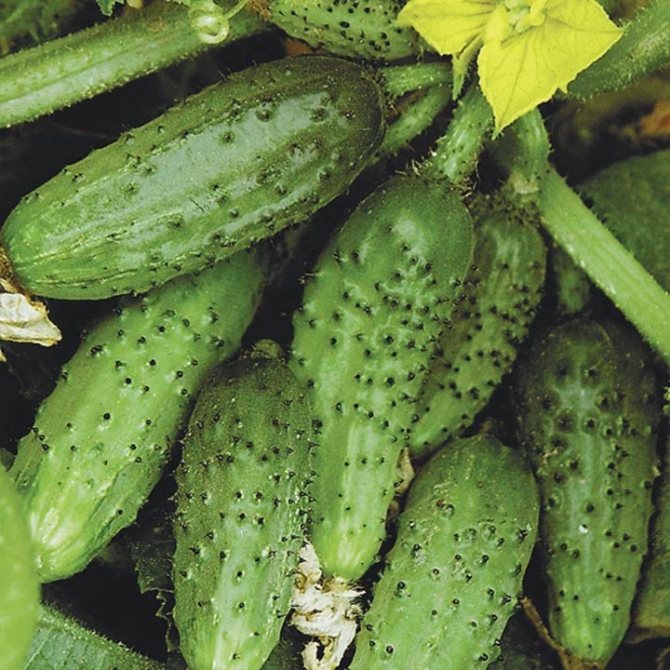

High-yielding cucumber bunch hybrids form 3-6 fruits per cluster
Breeders have bred many successful carpal hybrids of cucumbers: Boy with a finger, Prestige, Our Masha, Bouquet, Petrel, Blizzard, Friendly family, etc.
Melotria rough
Melotria originated in Africa. In our latitudes, it successfully grows and bears fruit by the seedling method. The fruits of this amazing cucumber are very reminiscent of small watermelons, 2-2.5 centimeters long, they taste like an ordinary cucumber.
Melotria is used in various salads, pickles and preserves. This variety of cucumbers ripens quickly - it begins to bear fruit on the 14th day after planting seedlings in the ground. Scourges grow up to 3 meters in length, later supports are needed. The vegetable should be planted on the sunny side and watered and fed abundantly every 10 days, alternately replacing the organic mineral fertilizing. At the first frost, the leaves do not change their color, but continue to turn green, so the owners of an exotic culture grow it as the main decoration of the site.
Seed treatment
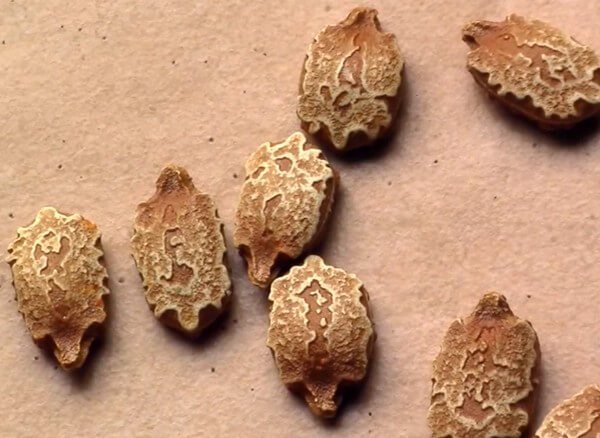

Photo momordica seeds
Momordica seeds are rather unusual in size, shape, and hard shell, which must be mechanically damaged - this is necessary to accelerate sprouting.
The sharpened end of the seed should be cut off with a nail file or sandpaper, or separated with pliers.


In the photo scarification of the seed
The seed should be soaked in a pale pink solution of potassium permanganate and a solution of "Epin" or a similar stimulant a day before planting in the ground.
Momordica
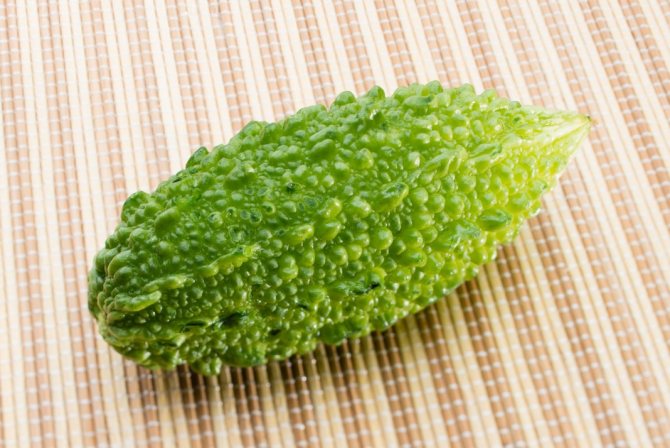

This exotic variety of cucumber of the pumpkin family has gained popularity among gardeners and landscape designers due to its decorative effect. The stems of this vegetable grow faster than those of other species, and reach up to two meters in length. The long stems are covered with wide dark green leaves smelling of jasmine. The fruit has an oval-elongated tuberous shape. The Momordika fruit is composed of charcoal lobules. Because of this structure, the cucumber outwardly resembles a crocodile with an open mouth, from which you can see juicy ruby pulp with variegated seeds that resemble watermelon seeds. For its resemblance to the green reptile, it is often called the "crocodile cucumber".
Ripe fruits have a sugary sweet taste with bitterness, and unripe fruits combine the taste of three vegetables at once: zucchini, pumpkin, cucumber. Not everyone likes such an unusual vegetable, but exotic gourmets enjoy it, especially in Asian dishes.
Planting Momordika in open ground is carried out at the end of May. The seeds are preliminarily scarified (they destroy the upper shell of the seeds to accelerate germination) at the beginning of spring. In the south, this crop can be immediately planted in open land, while in the middle latitudes, momordica can only be obtained through seedlings. Agrotechnology is identical with cucumbers.
Important! When working with Indian cucumbers, you should protect your hands by wearing protective gloves. The numerous hairs that cover the skin cause severe skin burns. The ripe crop does not provide fears.
Vegetative propagation
If you need to quickly propagate momordica, but there are not enough seeds, you can use the stepchildren of the plant, which it forms a lot, cuttings with two well-developed leaves are cut from the lower part of the stepson, put in a vessel with ordinary, but warm water (at least 25 ° C) ... After 12-14 days, the first roots will appear, and after a month, new plants can be planted in a permanent place, watered well and shaded for two to three days. Watering is best done in the evening (from 19 to 22 hours).
Trihozant
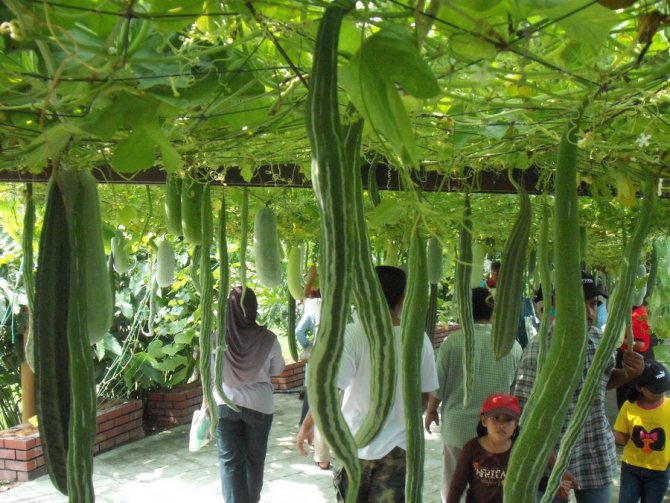

This representative, whose homeland is Southeast Asia, received the name "serpentine" due to the too long elongated and curved shape, like a snake.The fruits grow up to 1.5 meters and weigh 1 kilogram. Mature trichozant is painted fiery red. In the Russian Federation, trichozant is not widespread, but in the countries of Southeast Asia it grows everywhere as a vegetable crop and is used in food.
Trichozant is unpretentious to soil conditions, watering. In soil in open areas, it grows only in the southern territory. In mid-latitudes, it is preferable to cultivate an unusual cucumber in greenhouses.
Trichozant subspecies:
- Serpentine.
- Kukumerina.
- Petora Ular.
- Snake Guad.
In oriental cuisine, fresh shoots and fruits of the plant are used in dishes such as salads, soups, sauces, marinades, and more. They are also canned like ordinary cucumbers.
Recommendation! Trichozant contains a large amount of substances useful for the human body. Especially serpentine cucumber is rich in iron and is useful for everyone who has heart and vascular diseases. It is also common in folk oriental medicine: decoctions from the leaves reduce heat and temperature, the root in the form of powders helps with skin diseases and wounds. The vegetable promotes productive lactation by enriching breast milk.
Parthenocarpic (self-pollinated)
Cucumbers of this group can be planted exclusively in greenhouses and greenhouses under a film cover. The plant should be well protected from bad weather, wind and temperature extremes.
The advantages of the group include the fact that such cucumbers give a crop without pollination, that is, even without the participation of insects, in inclement weather. Fruiting is continuous, there are no seeds in the fruits, which significantly improves the structure of the fruits and their taste. The shoots of such cucumbers are quite large, powerful, vegetables are not bitter even with insufficient moisture.
Doubtful tladianta
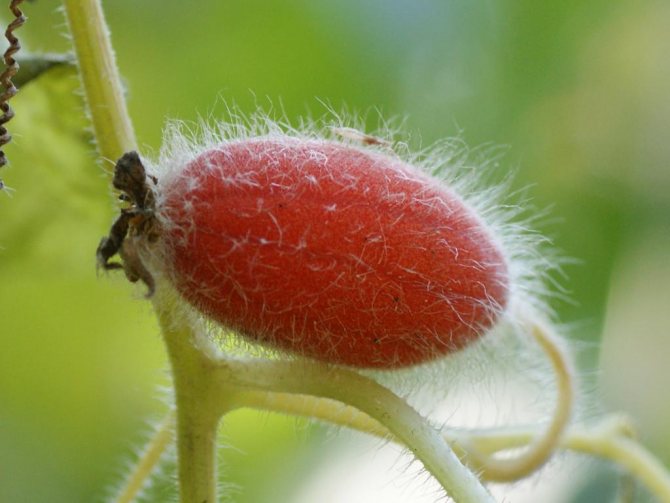

This perennial cucumber exotic was born in Southeast Asia. The plant is 5-6 meters long, and the cucumbers grow 5-6 centimeters in length. The unripe green tladiant is suitable exclusively for conservation. In the process of growth, the fruit turns red, saturated with sucrose, and can be used to make jam.
In late spring, seedlings are planted in the ground. Seedlings need moderate watering (with excessive watering, the tladiant dies). Pollination in central Russia is done manually, while in the homeland of the red cucumber it is done by insects that do not live in our area.
Important! Tladiana is grown in two ways: as potatoes with tubers and seeds. With the arrival of cold weather, the terrestrial section dies off, and the tubers remain overwintering in the soil. A red cucumber can bear fruit for about 10 years without changing its location.
There are actually more exotic vegetables, distant relatives of our beloved green cucumber, than described above. Most of them cannot be grown on the territory of Russia - they are too capricious to the composition of the soil and climate. The presented species can take root pretty well in Russian gardens. Don't believe me? Check it out!
Use in traditional medicine
For treatment with folk remedies, all parts of the plant are actively used. Decoctions, lotions, tinctures and compresses are prepared from them.
Decoction of seeds... To prepare the broth, you will need 250 ml of boiling water and dry cucumber seeds. The broth is brought to a boil and kept on fire for 15 minutes.
The remedy effectively helps against hemorrhoids, prostatitis, fever. It is used to improve vision.
Fresh seeds... The use of seeds helps to improve the functioning of the stomach and intestines. It is enough to chew 2-3 seeds once a day.
Roots and fruits... Decoctions and tinctures are prepared from dried momordica. They are well proven in the treatment of coughs during colds.
Fresh leaves... Fresh leaves are used for the preparation of decoctions and inhalations. In the case of arthritis, a decoction is prepared from the green shoots. It helps relieve pain.
Fruit pulp and juice... The pulp applied to the bites in the form of compresses allows you to relieve inflammation, remove itching, and reduce swelling. The juice is used for compresses for burns of varying degrees.
Overripe fruits have bitterness... Seeds, on the contrary, should be used only when ripe.
Healing properties of Momordica:
https://youtu.be/vkK53jIzfnk

